Analyzing the Impact of Ageing Population on Asian Economies
VerifiedAdded on 2023/01/18
|9
|2869
|36
Essay
AI Summary
This essay examines the significant economic challenges posed by the rapidly ageing population in Asia, focusing on the strain placed on pension schemes and the workforce. It highlights the impact of longer lifespans and declining birth rates on resource allocation. The essay explores the challenges faced by Asian economies and proposes solutions such as technological innovation, workplace reforms, and investments in human capital. It analyzes various policy options, including family support systems, incentives for elderly workforce participation, encouragement of personal savings, and public programs like national healthcare and pension schemes. The essay further discusses the business opportunities arising from age-related diseases and the need for businesses to adapt to the evolving needs of the ageing population. Ultimately, the essay emphasizes the importance of proactive measures to mitigate the economic pressures and harness the potential of an ageing workforce through innovation, policy adjustments, and strategic business models.

BUSINESS ECONOMICS
Paraphrase This Document
Need a fresh take? Get an instant paraphrase of this document with our AI Paraphraser
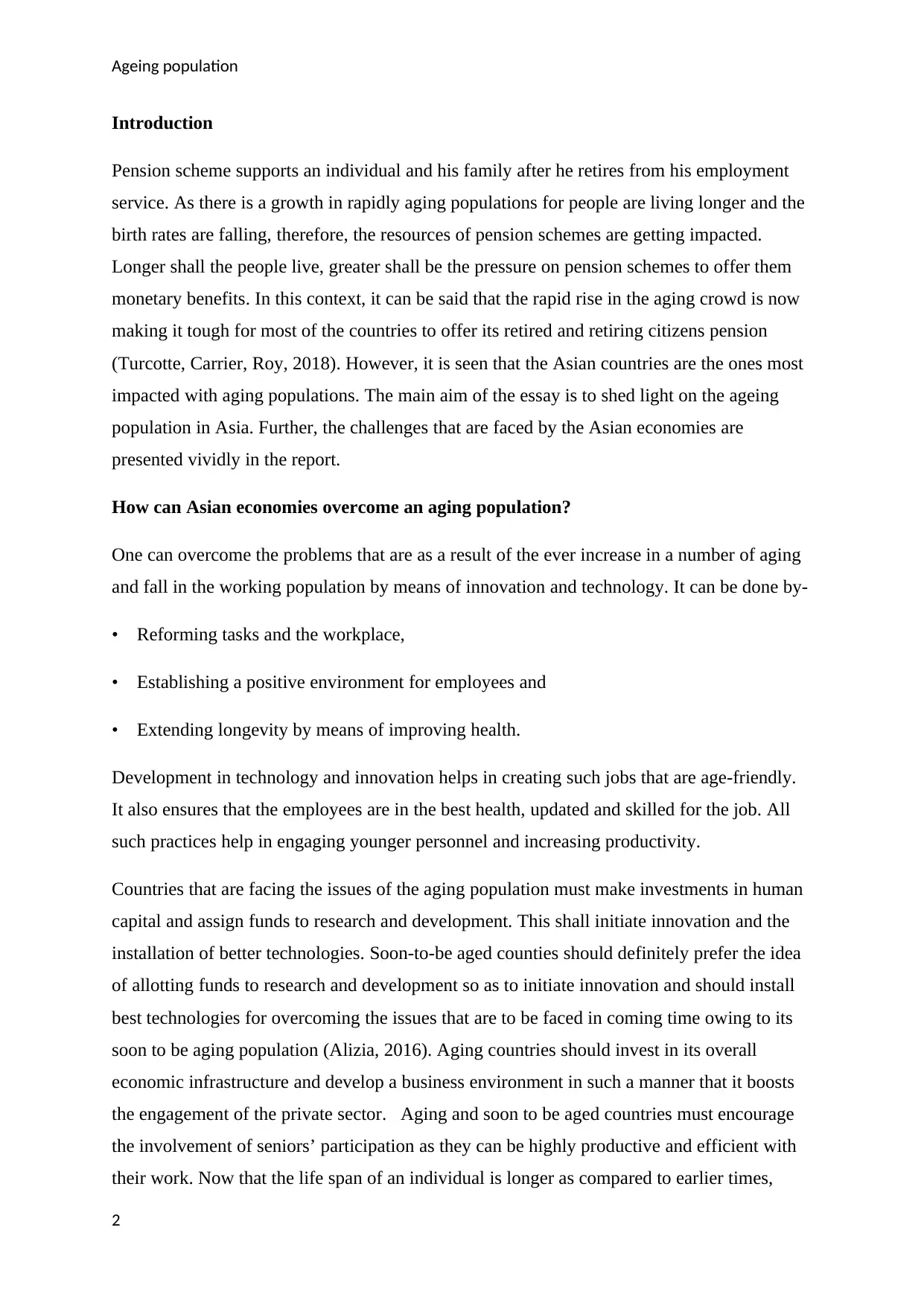
Ageing population
Introduction
Pension scheme supports an individual and his family after he retires from his employment
service. As there is a growth in rapidly aging populations for people are living longer and the
birth rates are falling, therefore, the resources of pension schemes are getting impacted.
Longer shall the people live, greater shall be the pressure on pension schemes to offer them
monetary benefits. In this context, it can be said that the rapid rise in the aging crowd is now
making it tough for most of the countries to offer its retired and retiring citizens pension
(Turcotte, Carrier, Roy, 2018). However, it is seen that the Asian countries are the ones most
impacted with aging populations. The main aim of the essay is to shed light on the ageing
population in Asia. Further, the challenges that are faced by the Asian economies are
presented vividly in the report.
How can Asian economies overcome an aging population?
One can overcome the problems that are as a result of the ever increase in a number of aging
and fall in the working population by means of innovation and technology. It can be done by-
• Reforming tasks and the workplace,
• Establishing a positive environment for employees and
• Extending longevity by means of improving health.
Development in technology and innovation helps in creating such jobs that are age-friendly.
It also ensures that the employees are in the best health, updated and skilled for the job. All
such practices help in engaging younger personnel and increasing productivity.
Countries that are facing the issues of the aging population must make investments in human
capital and assign funds to research and development. This shall initiate innovation and the
installation of better technologies. Soon-to-be aged counties should definitely prefer the idea
of allotting funds to research and development so as to initiate innovation and should install
best technologies for overcoming the issues that are to be faced in coming time owing to its
soon to be aging population (Alizia, 2016). Aging countries should invest in its overall
economic infrastructure and develop a business environment in such a manner that it boosts
the engagement of the private sector. Aging and soon to be aged countries must encourage
the involvement of seniors’ participation as they can be highly productive and efficient with
their work. Now that the life span of an individual is longer as compared to earlier times,
2
Introduction
Pension scheme supports an individual and his family after he retires from his employment
service. As there is a growth in rapidly aging populations for people are living longer and the
birth rates are falling, therefore, the resources of pension schemes are getting impacted.
Longer shall the people live, greater shall be the pressure on pension schemes to offer them
monetary benefits. In this context, it can be said that the rapid rise in the aging crowd is now
making it tough for most of the countries to offer its retired and retiring citizens pension
(Turcotte, Carrier, Roy, 2018). However, it is seen that the Asian countries are the ones most
impacted with aging populations. The main aim of the essay is to shed light on the ageing
population in Asia. Further, the challenges that are faced by the Asian economies are
presented vividly in the report.
How can Asian economies overcome an aging population?
One can overcome the problems that are as a result of the ever increase in a number of aging
and fall in the working population by means of innovation and technology. It can be done by-
• Reforming tasks and the workplace,
• Establishing a positive environment for employees and
• Extending longevity by means of improving health.
Development in technology and innovation helps in creating such jobs that are age-friendly.
It also ensures that the employees are in the best health, updated and skilled for the job. All
such practices help in engaging younger personnel and increasing productivity.
Countries that are facing the issues of the aging population must make investments in human
capital and assign funds to research and development. This shall initiate innovation and the
installation of better technologies. Soon-to-be aged counties should definitely prefer the idea
of allotting funds to research and development so as to initiate innovation and should install
best technologies for overcoming the issues that are to be faced in coming time owing to its
soon to be aging population (Alizia, 2016). Aging countries should invest in its overall
economic infrastructure and develop a business environment in such a manner that it boosts
the engagement of the private sector. Aging and soon to be aged countries must encourage
the involvement of seniors’ participation as they can be highly productive and efficient with
their work. Now that the life span of an individual is longer as compared to earlier times,
2
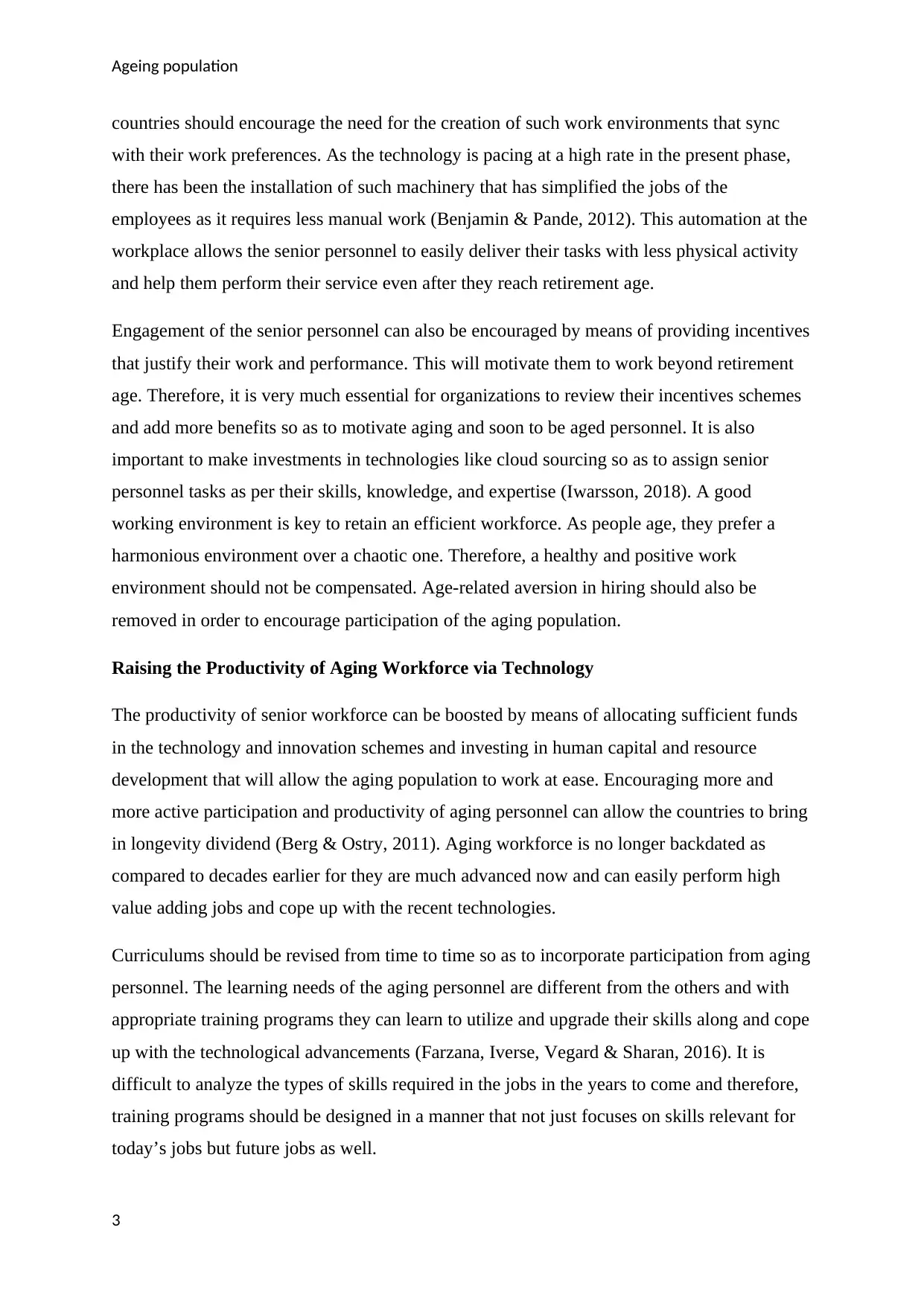
Ageing population
countries should encourage the need for the creation of such work environments that sync
with their work preferences. As the technology is pacing at a high rate in the present phase,
there has been the installation of such machinery that has simplified the jobs of the
employees as it requires less manual work (Benjamin & Pande, 2012). This automation at the
workplace allows the senior personnel to easily deliver their tasks with less physical activity
and help them perform their service even after they reach retirement age.
Engagement of the senior personnel can also be encouraged by means of providing incentives
that justify their work and performance. This will motivate them to work beyond retirement
age. Therefore, it is very much essential for organizations to review their incentives schemes
and add more benefits so as to motivate aging and soon to be aged personnel. It is also
important to make investments in technologies like cloud sourcing so as to assign senior
personnel tasks as per their skills, knowledge, and expertise (Iwarsson, 2018). A good
working environment is key to retain an efficient workforce. As people age, they prefer a
harmonious environment over a chaotic one. Therefore, a healthy and positive work
environment should not be compensated. Age-related aversion in hiring should also be
removed in order to encourage participation of the aging population.
Raising the Productivity of Aging Workforce via Technology
The productivity of senior workforce can be boosted by means of allocating sufficient funds
in the technology and innovation schemes and investing in human capital and resource
development that will allow the aging population to work at ease. Encouraging more and
more active participation and productivity of aging personnel can allow the countries to bring
in longevity dividend (Berg & Ostry, 2011). Aging workforce is no longer backdated as
compared to decades earlier for they are much advanced now and can easily perform high
value adding jobs and cope up with the recent technologies.
Curriculums should be revised from time to time so as to incorporate participation from aging
personnel. The learning needs of the aging personnel are different from the others and with
appropriate training programs they can learn to utilize and upgrade their skills along and cope
up with the technological advancements (Farzana, Iverse, Vegard & Sharan, 2016). It is
difficult to analyze the types of skills required in the jobs in the years to come and therefore,
training programs should be designed in a manner that not just focuses on skills relevant for
today’s jobs but future jobs as well.
3
countries should encourage the need for the creation of such work environments that sync
with their work preferences. As the technology is pacing at a high rate in the present phase,
there has been the installation of such machinery that has simplified the jobs of the
employees as it requires less manual work (Benjamin & Pande, 2012). This automation at the
workplace allows the senior personnel to easily deliver their tasks with less physical activity
and help them perform their service even after they reach retirement age.
Engagement of the senior personnel can also be encouraged by means of providing incentives
that justify their work and performance. This will motivate them to work beyond retirement
age. Therefore, it is very much essential for organizations to review their incentives schemes
and add more benefits so as to motivate aging and soon to be aged personnel. It is also
important to make investments in technologies like cloud sourcing so as to assign senior
personnel tasks as per their skills, knowledge, and expertise (Iwarsson, 2018). A good
working environment is key to retain an efficient workforce. As people age, they prefer a
harmonious environment over a chaotic one. Therefore, a healthy and positive work
environment should not be compensated. Age-related aversion in hiring should also be
removed in order to encourage participation of the aging population.
Raising the Productivity of Aging Workforce via Technology
The productivity of senior workforce can be boosted by means of allocating sufficient funds
in the technology and innovation schemes and investing in human capital and resource
development that will allow the aging population to work at ease. Encouraging more and
more active participation and productivity of aging personnel can allow the countries to bring
in longevity dividend (Berg & Ostry, 2011). Aging workforce is no longer backdated as
compared to decades earlier for they are much advanced now and can easily perform high
value adding jobs and cope up with the recent technologies.
Curriculums should be revised from time to time so as to incorporate participation from aging
personnel. The learning needs of the aging personnel are different from the others and with
appropriate training programs they can learn to utilize and upgrade their skills along and cope
up with the technological advancements (Farzana, Iverse, Vegard & Sharan, 2016). It is
difficult to analyze the types of skills required in the jobs in the years to come and therefore,
training programs should be designed in a manner that not just focuses on skills relevant for
today’s jobs but future jobs as well.
3
⊘ This is a preview!⊘
Do you want full access?
Subscribe today to unlock all pages.

Trusted by 1+ million students worldwide
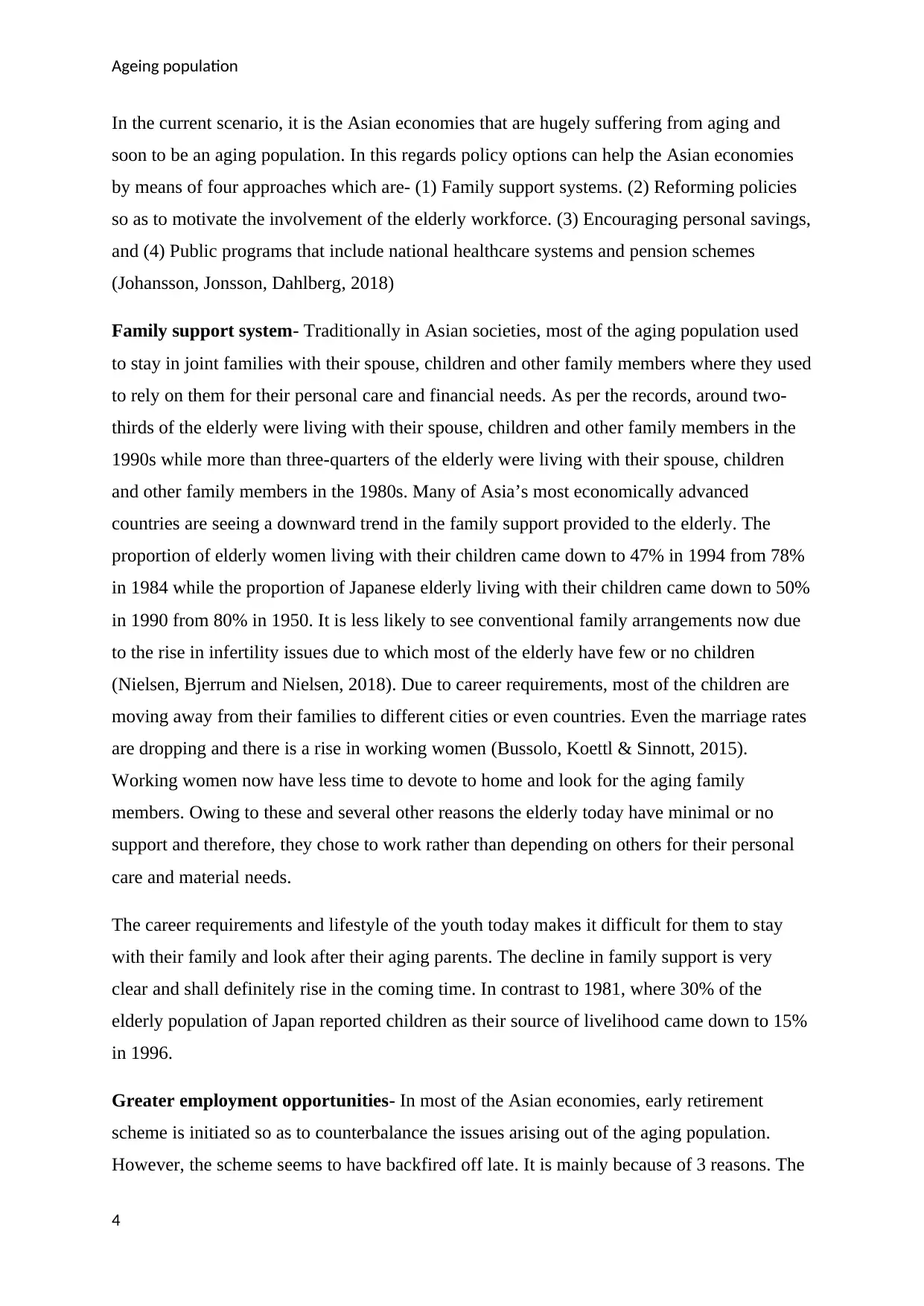
Ageing population
In the current scenario, it is the Asian economies that are hugely suffering from aging and
soon to be an aging population. In this regards policy options can help the Asian economies
by means of four approaches which are- (1) Family support systems. (2) Reforming policies
so as to motivate the involvement of the elderly workforce. (3) Encouraging personal savings,
and (4) Public programs that include national healthcare systems and pension schemes
(Johansson, Jonsson, Dahlberg, 2018)
Family support system- Traditionally in Asian societies, most of the aging population used
to stay in joint families with their spouse, children and other family members where they used
to rely on them for their personal care and financial needs. As per the records, around two-
thirds of the elderly were living with their spouse, children and other family members in the
1990s while more than three-quarters of the elderly were living with their spouse, children
and other family members in the 1980s. Many of Asia’s most economically advanced
countries are seeing a downward trend in the family support provided to the elderly. The
proportion of elderly women living with their children came down to 47% in 1994 from 78%
in 1984 while the proportion of Japanese elderly living with their children came down to 50%
in 1990 from 80% in 1950. It is less likely to see conventional family arrangements now due
to the rise in infertility issues due to which most of the elderly have few or no children
(Nielsen, Bjerrum and Nielsen, 2018). Due to career requirements, most of the children are
moving away from their families to different cities or even countries. Even the marriage rates
are dropping and there is a rise in working women (Bussolo, Koettl & Sinnott, 2015).
Working women now have less time to devote to home and look for the aging family
members. Owing to these and several other reasons the elderly today have minimal or no
support and therefore, they chose to work rather than depending on others for their personal
care and material needs.
The career requirements and lifestyle of the youth today makes it difficult for them to stay
with their family and look after their aging parents. The decline in family support is very
clear and shall definitely rise in the coming time. In contrast to 1981, where 30% of the
elderly population of Japan reported children as their source of livelihood came down to 15%
in 1996.
Greater employment opportunities- In most of the Asian economies, early retirement
scheme is initiated so as to counterbalance the issues arising out of the aging population.
However, the scheme seems to have backfired off late. It is mainly because of 3 reasons. The
4
In the current scenario, it is the Asian economies that are hugely suffering from aging and
soon to be an aging population. In this regards policy options can help the Asian economies
by means of four approaches which are- (1) Family support systems. (2) Reforming policies
so as to motivate the involvement of the elderly workforce. (3) Encouraging personal savings,
and (4) Public programs that include national healthcare systems and pension schemes
(Johansson, Jonsson, Dahlberg, 2018)
Family support system- Traditionally in Asian societies, most of the aging population used
to stay in joint families with their spouse, children and other family members where they used
to rely on them for their personal care and financial needs. As per the records, around two-
thirds of the elderly were living with their spouse, children and other family members in the
1990s while more than three-quarters of the elderly were living with their spouse, children
and other family members in the 1980s. Many of Asia’s most economically advanced
countries are seeing a downward trend in the family support provided to the elderly. The
proportion of elderly women living with their children came down to 47% in 1994 from 78%
in 1984 while the proportion of Japanese elderly living with their children came down to 50%
in 1990 from 80% in 1950. It is less likely to see conventional family arrangements now due
to the rise in infertility issues due to which most of the elderly have few or no children
(Nielsen, Bjerrum and Nielsen, 2018). Due to career requirements, most of the children are
moving away from their families to different cities or even countries. Even the marriage rates
are dropping and there is a rise in working women (Bussolo, Koettl & Sinnott, 2015).
Working women now have less time to devote to home and look for the aging family
members. Owing to these and several other reasons the elderly today have minimal or no
support and therefore, they chose to work rather than depending on others for their personal
care and material needs.
The career requirements and lifestyle of the youth today makes it difficult for them to stay
with their family and look after their aging parents. The decline in family support is very
clear and shall definitely rise in the coming time. In contrast to 1981, where 30% of the
elderly population of Japan reported children as their source of livelihood came down to 15%
in 1996.
Greater employment opportunities- In most of the Asian economies, early retirement
scheme is initiated so as to counterbalance the issues arising out of the aging population.
However, the scheme seems to have backfired off late. It is mainly because of 3 reasons. The
4
Paraphrase This Document
Need a fresh take? Get an instant paraphrase of this document with our AI Paraphraser
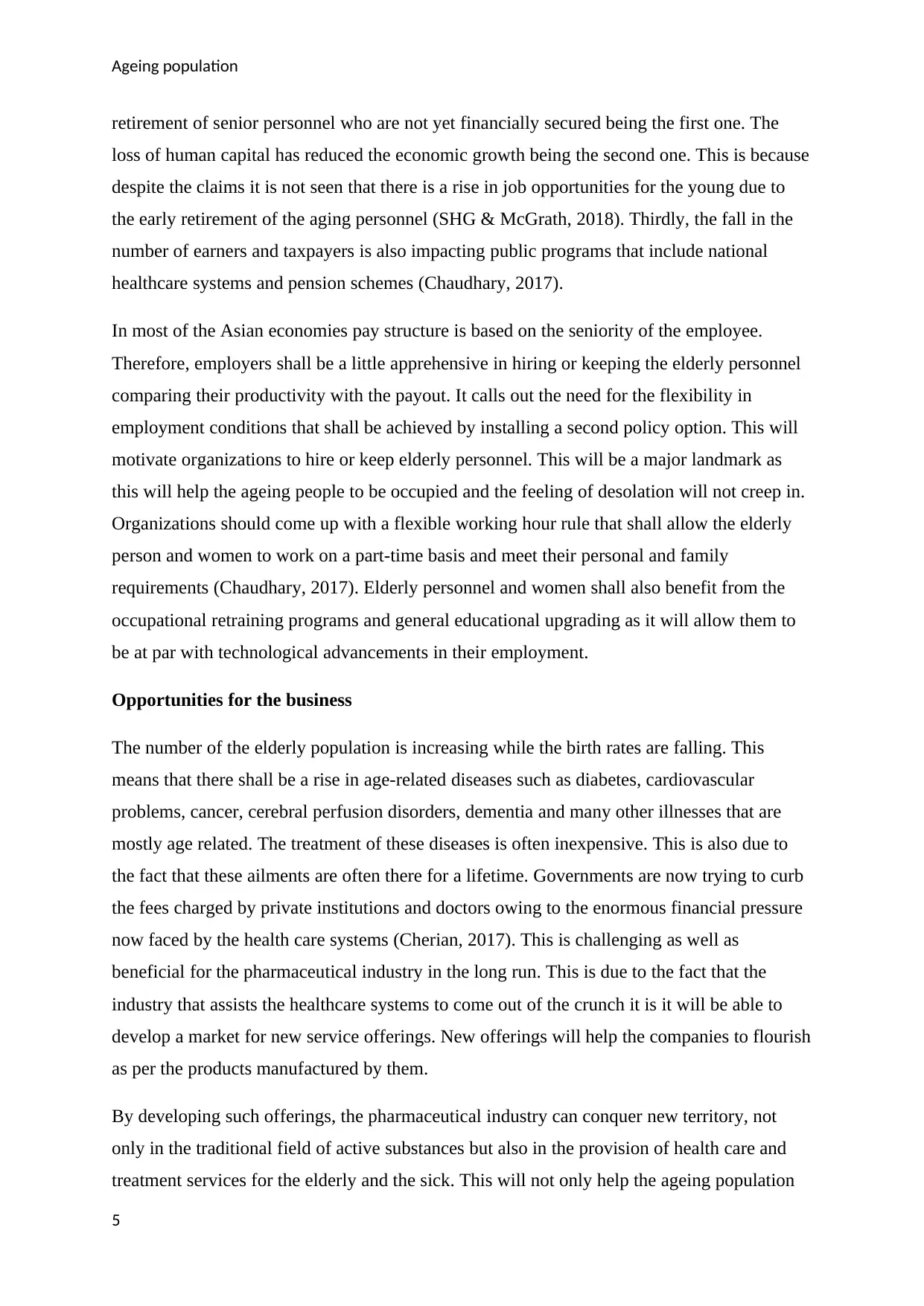
Ageing population
retirement of senior personnel who are not yet financially secured being the first one. The
loss of human capital has reduced the economic growth being the second one. This is because
despite the claims it is not seen that there is a rise in job opportunities for the young due to
the early retirement of the aging personnel (SHG & McGrath, 2018). Thirdly, the fall in the
number of earners and taxpayers is also impacting public programs that include national
healthcare systems and pension schemes (Chaudhary, 2017).
In most of the Asian economies pay structure is based on the seniority of the employee.
Therefore, employers shall be a little apprehensive in hiring or keeping the elderly personnel
comparing their productivity with the payout. It calls out the need for the flexibility in
employment conditions that shall be achieved by installing a second policy option. This will
motivate organizations to hire or keep elderly personnel. This will be a major landmark as
this will help the ageing people to be occupied and the feeling of desolation will not creep in.
Organizations should come up with a flexible working hour rule that shall allow the elderly
person and women to work on a part-time basis and meet their personal and family
requirements (Chaudhary, 2017). Elderly personnel and women shall also benefit from the
occupational retraining programs and general educational upgrading as it will allow them to
be at par with technological advancements in their employment.
Opportunities for the business
The number of the elderly population is increasing while the birth rates are falling. This
means that there shall be a rise in age-related diseases such as diabetes, cardiovascular
problems, cancer, cerebral perfusion disorders, dementia and many other illnesses that are
mostly age related. The treatment of these diseases is often inexpensive. This is also due to
the fact that these ailments are often there for a lifetime. Governments are now trying to curb
the fees charged by private institutions and doctors owing to the enormous financial pressure
now faced by the health care systems (Cherian, 2017). This is challenging as well as
beneficial for the pharmaceutical industry in the long run. This is due to the fact that the
industry that assists the healthcare systems to come out of the crunch it is it will be able to
develop a market for new service offerings. New offerings will help the companies to flourish
as per the products manufactured by them.
By developing such offerings, the pharmaceutical industry can conquer new territory, not
only in the traditional field of active substances but also in the provision of health care and
treatment services for the elderly and the sick. This will not only help the ageing population
5
retirement of senior personnel who are not yet financially secured being the first one. The
loss of human capital has reduced the economic growth being the second one. This is because
despite the claims it is not seen that there is a rise in job opportunities for the young due to
the early retirement of the aging personnel (SHG & McGrath, 2018). Thirdly, the fall in the
number of earners and taxpayers is also impacting public programs that include national
healthcare systems and pension schemes (Chaudhary, 2017).
In most of the Asian economies pay structure is based on the seniority of the employee.
Therefore, employers shall be a little apprehensive in hiring or keeping the elderly personnel
comparing their productivity with the payout. It calls out the need for the flexibility in
employment conditions that shall be achieved by installing a second policy option. This will
motivate organizations to hire or keep elderly personnel. This will be a major landmark as
this will help the ageing people to be occupied and the feeling of desolation will not creep in.
Organizations should come up with a flexible working hour rule that shall allow the elderly
person and women to work on a part-time basis and meet their personal and family
requirements (Chaudhary, 2017). Elderly personnel and women shall also benefit from the
occupational retraining programs and general educational upgrading as it will allow them to
be at par with technological advancements in their employment.
Opportunities for the business
The number of the elderly population is increasing while the birth rates are falling. This
means that there shall be a rise in age-related diseases such as diabetes, cardiovascular
problems, cancer, cerebral perfusion disorders, dementia and many other illnesses that are
mostly age related. The treatment of these diseases is often inexpensive. This is also due to
the fact that these ailments are often there for a lifetime. Governments are now trying to curb
the fees charged by private institutions and doctors owing to the enormous financial pressure
now faced by the health care systems (Cherian, 2017). This is challenging as well as
beneficial for the pharmaceutical industry in the long run. This is due to the fact that the
industry that assists the healthcare systems to come out of the crunch it is it will be able to
develop a market for new service offerings. New offerings will help the companies to flourish
as per the products manufactured by them.
By developing such offerings, the pharmaceutical industry can conquer new territory, not
only in the traditional field of active substances but also in the provision of health care and
treatment services for the elderly and the sick. This will not only help the ageing population
5
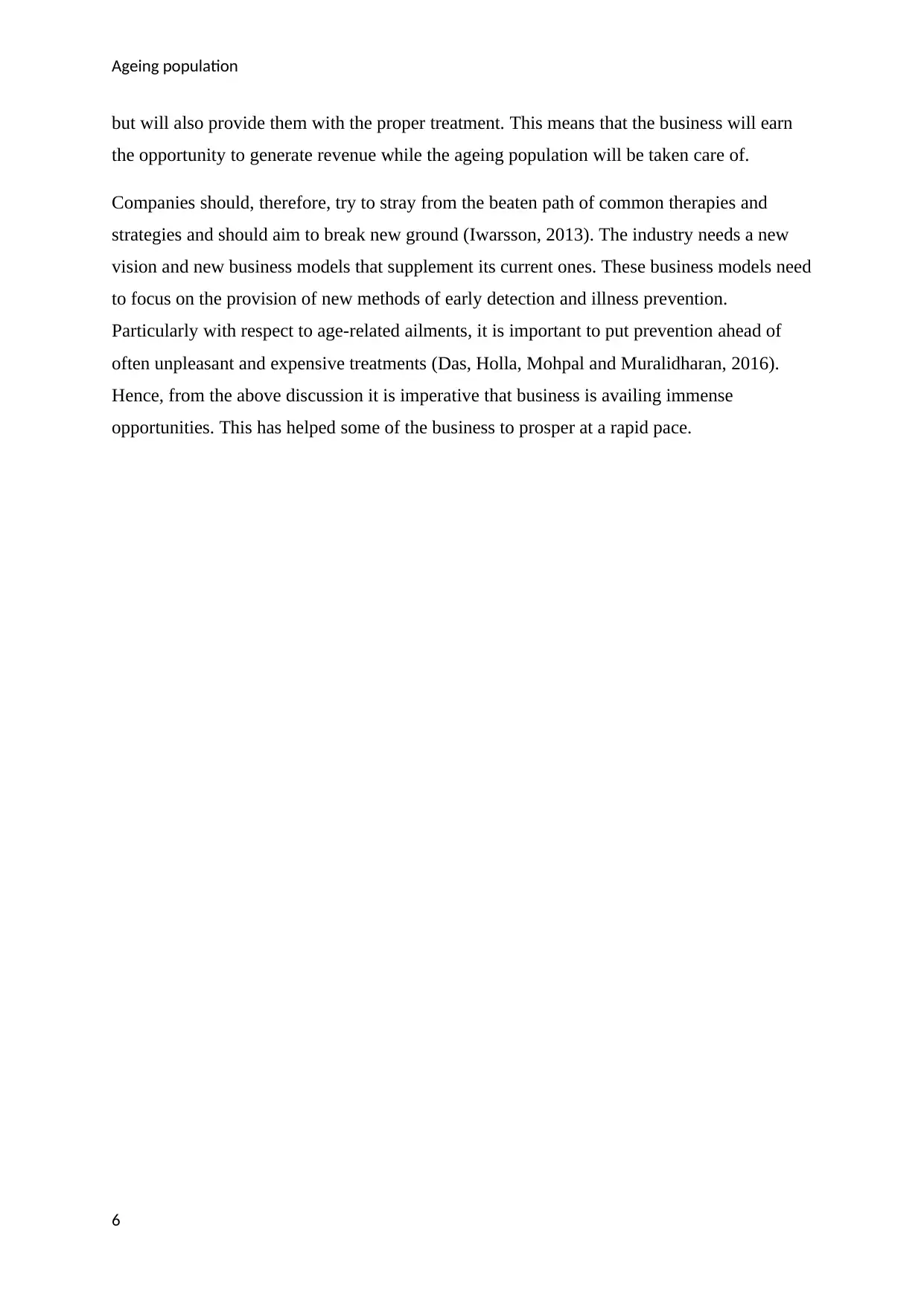
Ageing population
but will also provide them with the proper treatment. This means that the business will earn
the opportunity to generate revenue while the ageing population will be taken care of.
Companies should, therefore, try to stray from the beaten path of common therapies and
strategies and should aim to break new ground (Iwarsson, 2013). The industry needs a new
vision and new business models that supplement its current ones. These business models need
to focus on the provision of new methods of early detection and illness prevention.
Particularly with respect to age-related ailments, it is important to put prevention ahead of
often unpleasant and expensive treatments (Das, Holla, Mohpal and Muralidharan, 2016).
Hence, from the above discussion it is imperative that business is availing immense
opportunities. This has helped some of the business to prosper at a rapid pace.
6
but will also provide them with the proper treatment. This means that the business will earn
the opportunity to generate revenue while the ageing population will be taken care of.
Companies should, therefore, try to stray from the beaten path of common therapies and
strategies and should aim to break new ground (Iwarsson, 2013). The industry needs a new
vision and new business models that supplement its current ones. These business models need
to focus on the provision of new methods of early detection and illness prevention.
Particularly with respect to age-related ailments, it is important to put prevention ahead of
often unpleasant and expensive treatments (Das, Holla, Mohpal and Muralidharan, 2016).
Hence, from the above discussion it is imperative that business is availing immense
opportunities. This has helped some of the business to prosper at a rapid pace.
6
⊘ This is a preview!⊘
Do you want full access?
Subscribe today to unlock all pages.

Trusted by 1+ million students worldwide
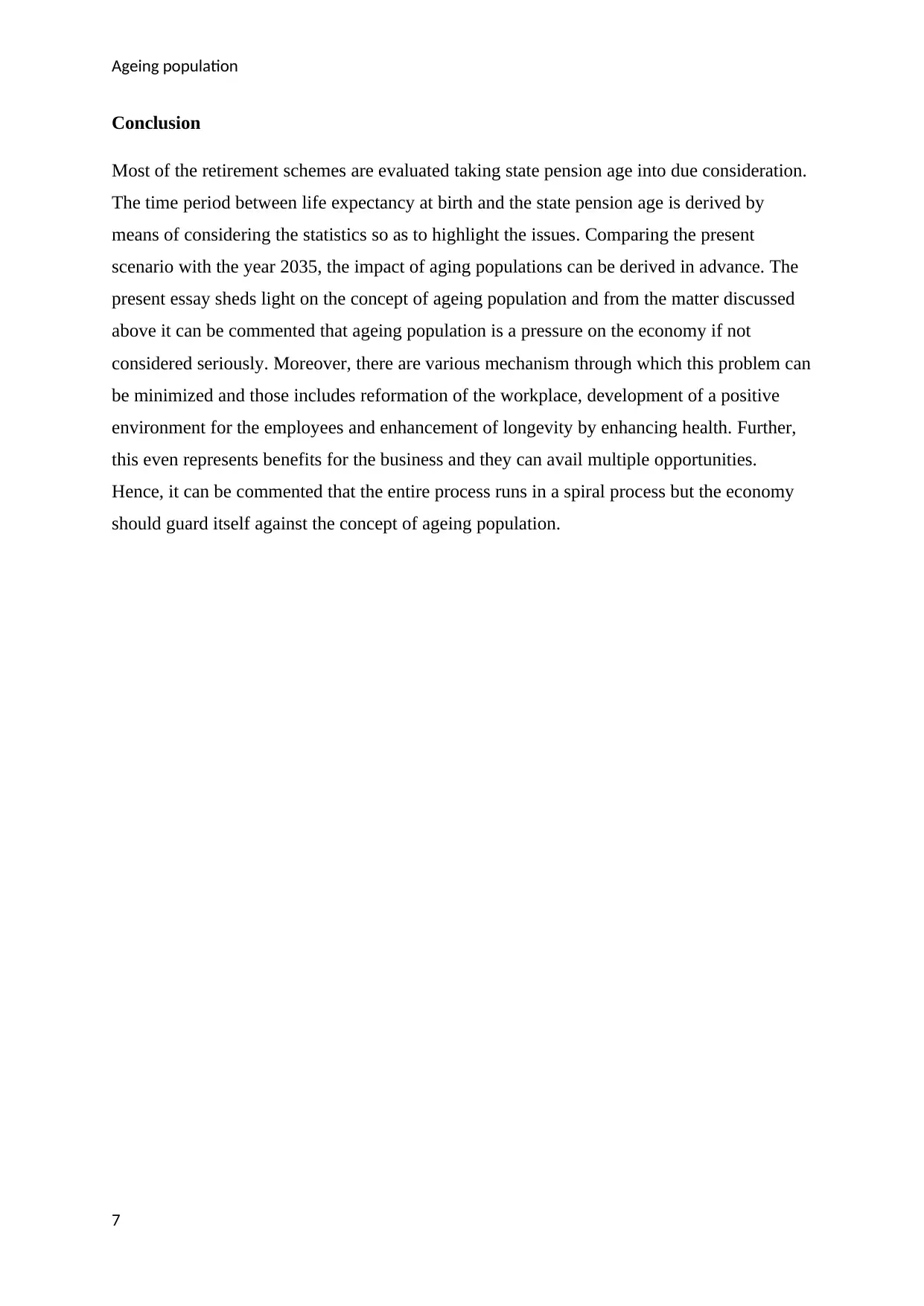
Ageing population
Conclusion
Most of the retirement schemes are evaluated taking state pension age into due consideration.
The time period between life expectancy at birth and the state pension age is derived by
means of considering the statistics so as to highlight the issues. Comparing the present
scenario with the year 2035, the impact of aging populations can be derived in advance. The
present essay sheds light on the concept of ageing population and from the matter discussed
above it can be commented that ageing population is a pressure on the economy if not
considered seriously. Moreover, there are various mechanism through which this problem can
be minimized and those includes reformation of the workplace, development of a positive
environment for the employees and enhancement of longevity by enhancing health. Further,
this even represents benefits for the business and they can avail multiple opportunities.
Hence, it can be commented that the entire process runs in a spiral process but the economy
should guard itself against the concept of ageing population.
7
Conclusion
Most of the retirement schemes are evaluated taking state pension age into due consideration.
The time period between life expectancy at birth and the state pension age is derived by
means of considering the statistics so as to highlight the issues. Comparing the present
scenario with the year 2035, the impact of aging populations can be derived in advance. The
present essay sheds light on the concept of ageing population and from the matter discussed
above it can be commented that ageing population is a pressure on the economy if not
considered seriously. Moreover, there are various mechanism through which this problem can
be minimized and those includes reformation of the workplace, development of a positive
environment for the employees and enhancement of longevity by enhancing health. Further,
this even represents benefits for the business and they can avail multiple opportunities.
Hence, it can be commented that the entire process runs in a spiral process but the economy
should guard itself against the concept of ageing population.
7
Paraphrase This Document
Need a fresh take? Get an instant paraphrase of this document with our AI Paraphraser
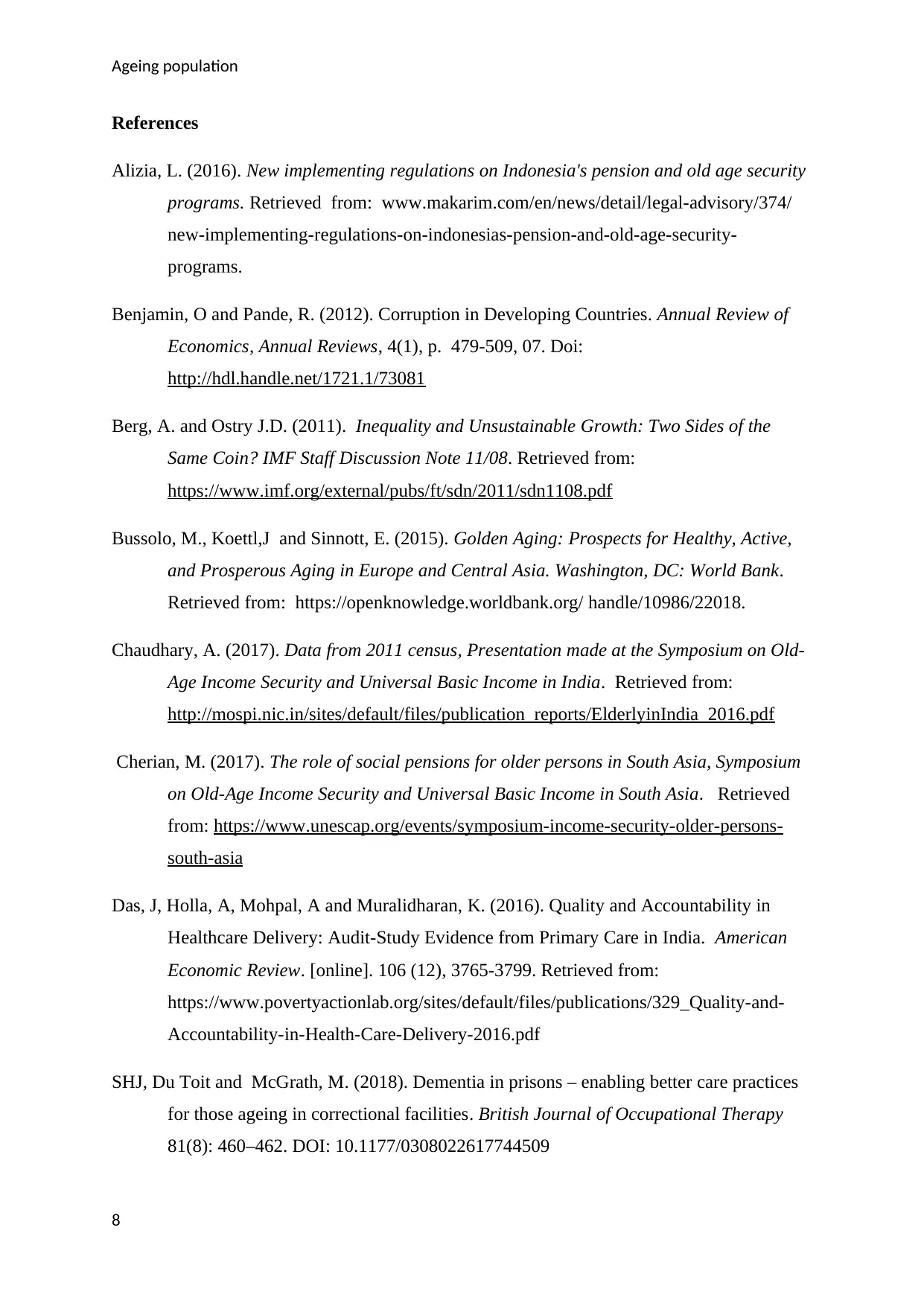
Ageing population
References
Alizia, L. (2016). New implementing regulations on Indonesia's pension and old age security
programs. Retrieved from: www.makarim.com/en/news/detail/legal-advisory/374/
new-implementing-regulations-on-indonesias-pension-and-old-age-security-
programs.
Benjamin, O and Pande, R. (2012). Corruption in Developing Countries. Annual Review of
Economics, Annual Reviews, 4(1), p. 479-509, 07. Doi:
http://hdl.handle.net/1721.1/73081
Berg, A. and Ostry J.D. (2011). Inequality and Unsustainable Growth: Two Sides of the
Same Coin? IMF Staff Discussion Note 11/08. Retrieved from:
https://www.imf.org/external/pubs/ft/sdn/2011/sdn1108.pdf
Bussolo, M., Koettl,J and Sinnott, E. (2015). Golden Aging: Prospects for Healthy, Active,
and Prosperous Aging in Europe and Central Asia. Washington, DC: World Bank.
Retrieved from: https://openknowledge.worldbank.org/ handle/10986/22018.
Chaudhary, A. (2017). Data from 2011 census, Presentation made at the Symposium on Old-
Age Income Security and Universal Basic Income in India. Retrieved from:
http://mospi.nic.in/sites/default/files/publication_reports/ElderlyinIndia_2016.pdf
Cherian, M. (2017). The role of social pensions for older persons in South Asia, Symposium
on Old-Age Income Security and Universal Basic Income in South Asia. Retrieved
from: https://www.unescap.org/events/symposium-income-security-older-persons-
south-asia
Das, J, Holla, A, Mohpal, A and Muralidharan, K. (2016). Quality and Accountability in
Healthcare Delivery: Audit-Study Evidence from Primary Care in India. American
Economic Review. [online]. 106 (12), 3765-3799. Retrieved from:
https://www.povertyactionlab.org/sites/default/files/publications/329_Quality-and-
Accountability-in-Health-Care-Delivery-2016.pdf
SHJ, Du Toit and McGrath, M. (2018). Dementia in prisons – enabling better care practices
for those ageing in correctional facilities. British Journal of Occupational Therapy
81(8): 460–462. DOI: 10.1177/0308022617744509
8
References
Alizia, L. (2016). New implementing regulations on Indonesia's pension and old age security
programs. Retrieved from: www.makarim.com/en/news/detail/legal-advisory/374/
new-implementing-regulations-on-indonesias-pension-and-old-age-security-
programs.
Benjamin, O and Pande, R. (2012). Corruption in Developing Countries. Annual Review of
Economics, Annual Reviews, 4(1), p. 479-509, 07. Doi:
http://hdl.handle.net/1721.1/73081
Berg, A. and Ostry J.D. (2011). Inequality and Unsustainable Growth: Two Sides of the
Same Coin? IMF Staff Discussion Note 11/08. Retrieved from:
https://www.imf.org/external/pubs/ft/sdn/2011/sdn1108.pdf
Bussolo, M., Koettl,J and Sinnott, E. (2015). Golden Aging: Prospects for Healthy, Active,
and Prosperous Aging in Europe and Central Asia. Washington, DC: World Bank.
Retrieved from: https://openknowledge.worldbank.org/ handle/10986/22018.
Chaudhary, A. (2017). Data from 2011 census, Presentation made at the Symposium on Old-
Age Income Security and Universal Basic Income in India. Retrieved from:
http://mospi.nic.in/sites/default/files/publication_reports/ElderlyinIndia_2016.pdf
Cherian, M. (2017). The role of social pensions for older persons in South Asia, Symposium
on Old-Age Income Security and Universal Basic Income in South Asia. Retrieved
from: https://www.unescap.org/events/symposium-income-security-older-persons-
south-asia
Das, J, Holla, A, Mohpal, A and Muralidharan, K. (2016). Quality and Accountability in
Healthcare Delivery: Audit-Study Evidence from Primary Care in India. American
Economic Review. [online]. 106 (12), 3765-3799. Retrieved from:
https://www.povertyactionlab.org/sites/default/files/publications/329_Quality-and-
Accountability-in-Health-Care-Delivery-2016.pdf
SHJ, Du Toit and McGrath, M. (2018). Dementia in prisons – enabling better care practices
for those ageing in correctional facilities. British Journal of Occupational Therapy
81(8): 460–462. DOI: 10.1177/0308022617744509
8
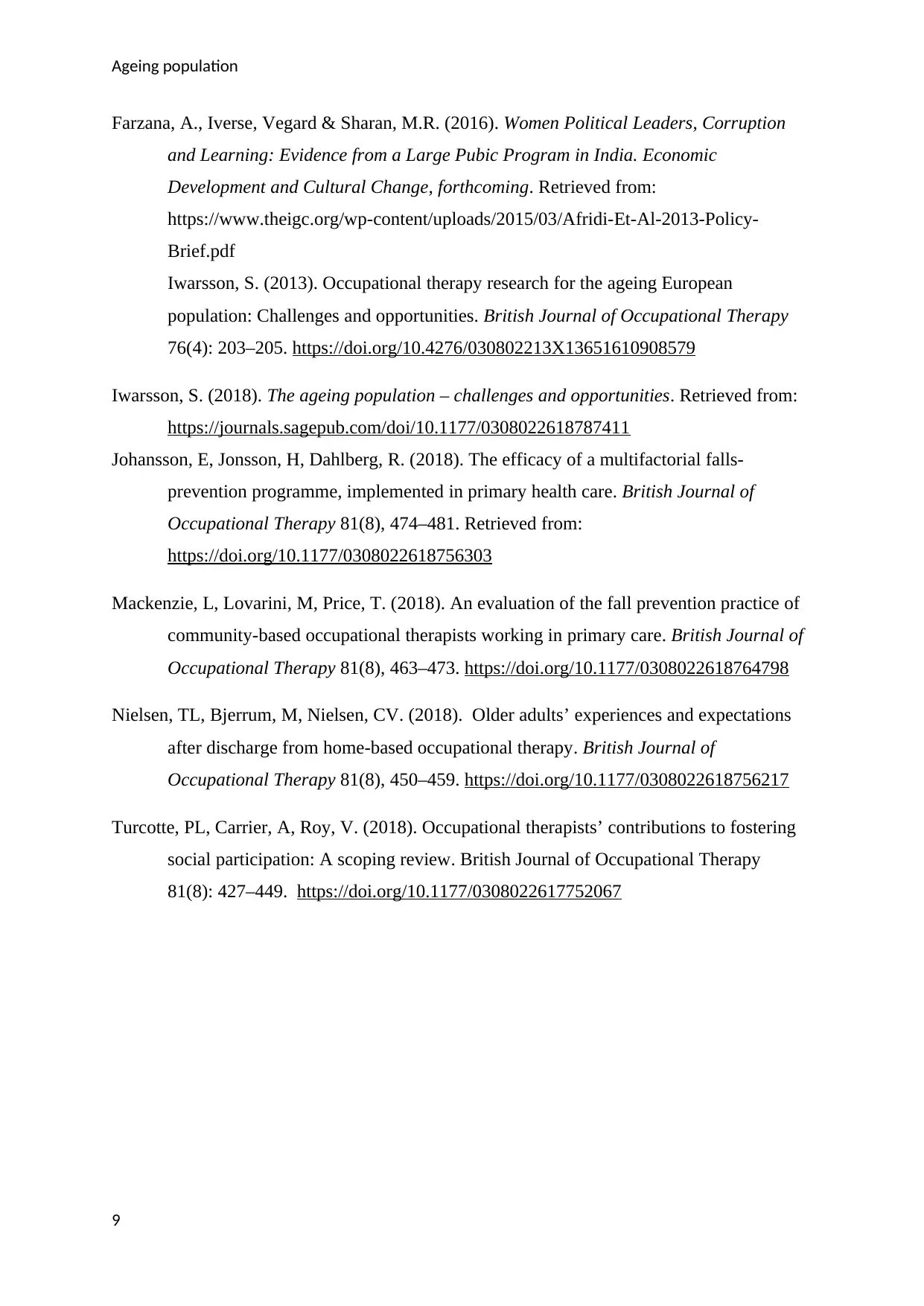
Ageing population
Farzana, A., Iverse, Vegard & Sharan, M.R. (2016). Women Political Leaders, Corruption
and Learning: Evidence from a Large Pubic Program in India. Economic
Development and Cultural Change, forthcoming. Retrieved from:
https://www.theigc.org/wp-content/uploads/2015/03/Afridi-Et-Al-2013-Policy-
Brief.pdf
Iwarsson, S. (2013). Occupational therapy research for the ageing European
population: Challenges and opportunities. British Journal of Occupational Therapy
76(4): 203–205. https://doi.org/10.4276/030802213X13651610908579
Iwarsson, S. (2018). The ageing population – challenges and opportunities. Retrieved from:
https://journals.sagepub.com/doi/10.1177/0308022618787411
Johansson, E, Jonsson, H, Dahlberg, R. (2018). The efficacy of a multifactorial falls-
prevention programme, implemented in primary health care. British Journal of
Occupational Therapy 81(8), 474–481. Retrieved from:
https://doi.org/10.1177/0308022618756303
Mackenzie, L, Lovarini, M, Price, T. (2018). An evaluation of the fall prevention practice of
community-based occupational therapists working in primary care. British Journal of
Occupational Therapy 81(8), 463–473. https://doi.org/10.1177/0308022618764798
Nielsen, TL, Bjerrum, M, Nielsen, CV. (2018). Older adults’ experiences and expectations
after discharge from home-based occupational therapy. British Journal of
Occupational Therapy 81(8), 450–459. https://doi.org/10.1177/0308022618756217
Turcotte, PL, Carrier, A, Roy, V. (2018). Occupational therapists’ contributions to fostering
social participation: A scoping review. British Journal of Occupational Therapy
81(8): 427–449. https://doi.org/10.1177/0308022617752067
9
Farzana, A., Iverse, Vegard & Sharan, M.R. (2016). Women Political Leaders, Corruption
and Learning: Evidence from a Large Pubic Program in India. Economic
Development and Cultural Change, forthcoming. Retrieved from:
https://www.theigc.org/wp-content/uploads/2015/03/Afridi-Et-Al-2013-Policy-
Brief.pdf
Iwarsson, S. (2013). Occupational therapy research for the ageing European
population: Challenges and opportunities. British Journal of Occupational Therapy
76(4): 203–205. https://doi.org/10.4276/030802213X13651610908579
Iwarsson, S. (2018). The ageing population – challenges and opportunities. Retrieved from:
https://journals.sagepub.com/doi/10.1177/0308022618787411
Johansson, E, Jonsson, H, Dahlberg, R. (2018). The efficacy of a multifactorial falls-
prevention programme, implemented in primary health care. British Journal of
Occupational Therapy 81(8), 474–481. Retrieved from:
https://doi.org/10.1177/0308022618756303
Mackenzie, L, Lovarini, M, Price, T. (2018). An evaluation of the fall prevention practice of
community-based occupational therapists working in primary care. British Journal of
Occupational Therapy 81(8), 463–473. https://doi.org/10.1177/0308022618764798
Nielsen, TL, Bjerrum, M, Nielsen, CV. (2018). Older adults’ experiences and expectations
after discharge from home-based occupational therapy. British Journal of
Occupational Therapy 81(8), 450–459. https://doi.org/10.1177/0308022618756217
Turcotte, PL, Carrier, A, Roy, V. (2018). Occupational therapists’ contributions to fostering
social participation: A scoping review. British Journal of Occupational Therapy
81(8): 427–449. https://doi.org/10.1177/0308022617752067
9
⊘ This is a preview!⊘
Do you want full access?
Subscribe today to unlock all pages.

Trusted by 1+ million students worldwide
1 out of 9
Your All-in-One AI-Powered Toolkit for Academic Success.
+13062052269
info@desklib.com
Available 24*7 on WhatsApp / Email
![[object Object]](/_next/static/media/star-bottom.7253800d.svg)
Unlock your academic potential
Copyright © 2020–2025 A2Z Services. All Rights Reserved. Developed and managed by ZUCOL.

